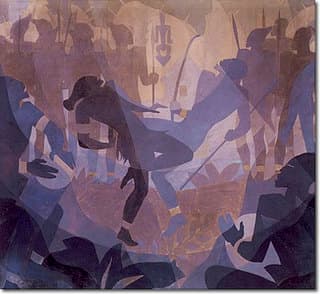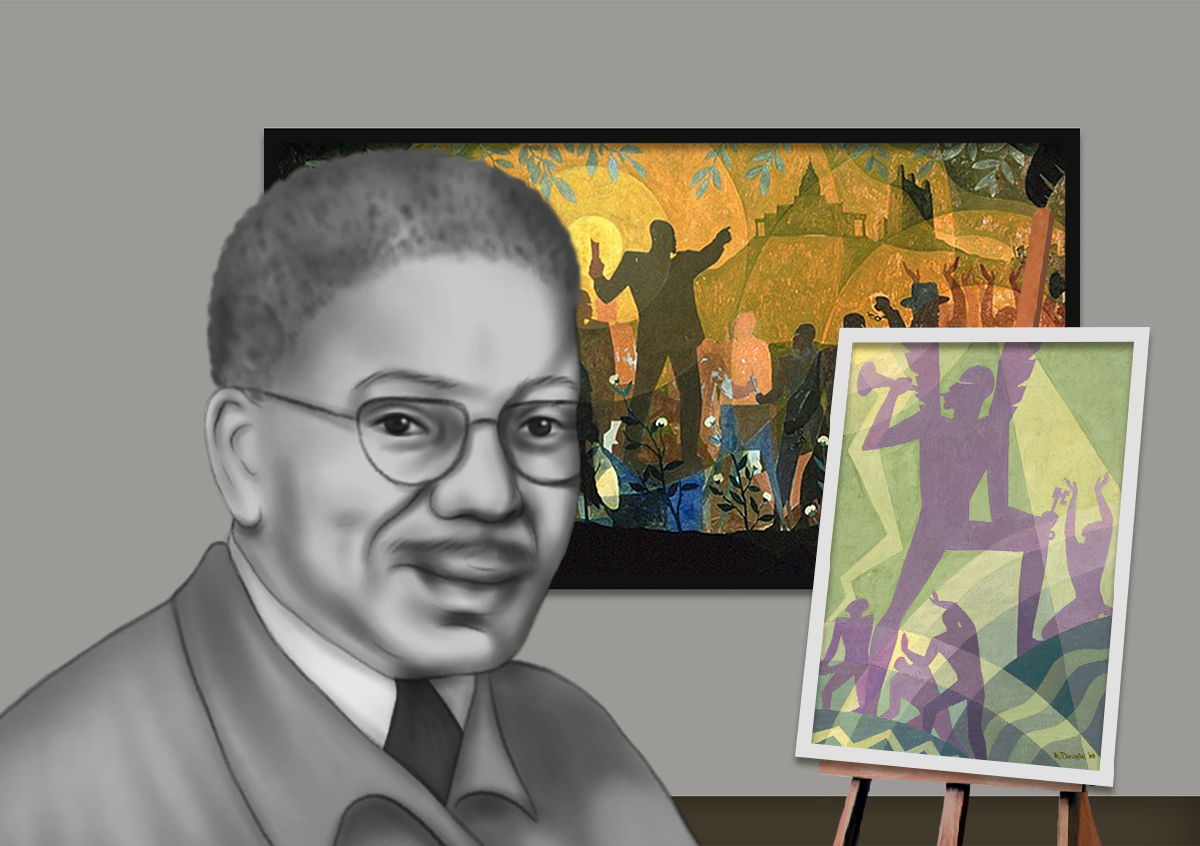A leader within the Harlem Renaissance Douglas created a broad range of work that helped to shape this movement and bring it to national prominence. Clear-cut delineation change of shadows and light stylized human bodies and geometric figures as concentric.

How Artist Aaron Douglas Put Music Into His Murals Interlude
Aaron Douglas and the Harlem Renaissance.

. He held a distinctive position as a prominent figure in the Harlem Renaissance that explored the cultural. Aaron Douglas was an African American painter and graphic artist who played a leading role in the Harlem Renaissance of the 1920s and 1930s. This painting resembles the great migration and it outlines black history from Africa.
Aaron Douglas was a. Douglas drew inspiration from this powerful cultural movement that encompassed all fields of art and advocated celebration of African. 19351939 Metropolitan Museum of Art and The Judgment Day1939 National Gallery of.
In both his style and his subjects Aaron Douglas revolutionized African-American art. Douglas first traveling retrospective representing all of his mural projects as well as easel paintings and illustrations is making its. The four murals part of the series Aspects of Negro Life were produced by Douglas in 1934.
Aaron Douglas was an African-American painter illustrator and visual arts educator. Create murals about the African American experience. Song of the Towers is the first piece of art work from Aaron Douglas that expresses the theme of racism.
Aspects of Negro Life. Aaron Douglas Crucifixion Throughout much of Modernism many artists were influenced and informed by the work of exotic regions throughout the world more specifically Africa. He was a major figure in the Harlem Renaissance.
The works visually trace the emergence of Black America starting from their African homeland to their histories in slavery the emancipation and the. He developed his art career painting murals and creating illustrations that addressed social issues around race and segregation in the United States by utilizing African-centric imagery. New York and Washington DCThe Metropolitan Museum of Art and the National Gallery of Art have each acquired a significant work by the leading visual artist of the Harlem Renaissance Aaron Douglas American 18991979.
After graduating from Topeka High School in 1917 Douglas received a bachelors of fine arts from the University of Nebraska in 1922. He attended a segregated primary school McKinley Elementary and Topeka High School which was integrated. Aaron Douglas Painter at 79.
Browse and Bid Now. This piece uses geometric shapes and graphic designs. History is filled with countless valuable contributions of African Americans among them is the preeminent artist Aaron Douglas.
This painting focuses on African Americans after the Civil War. He was not only a painter but also an illustrator and an educator of arts. Aaron Douglas was born on May 26th 1899 in Topeka Kansas.
African American Modernist which was presented in Lawrence in Nashville at the Frist Center for the Visual Arts and in Washington DC. The picture Into Bondage created by Aaron Douglas appeared in this very period of time. Aaron Douglas a native of Kansas studied art in Nebraska before going to Paris and finally settling in New York City where he became part of the flourishing art scene of the 1920s and 1930s known as Harlem Renaissance.
Aaron Douglas was an American painter artist and visual expressions teacher. It was published in James Weldon Johnson s Gods Trombones in 1927. The given picture is one of four others that represent the way African Americans had to pass to become free.
Aaron Douglass paintings at the 1936 Texas Centennial Exposition focused on how the rich African past inspired a bright future for African Americans even in the midst of Jim Crow and the Great DepressionAPUSH. 1 Following graduation Douglas worked in a glass factory and. One of Aaron Douglas s most popular paintings is The Crucifixion 1.
Frist Art Museum Nashville TN January 19-April 13 2008. Charleston was created in 1928 by Aaron Douglas in Art Deco style. Aaron Douglas widely acknowledged as one of the most accomplished and influential visual artists of the Harlem Renaissance was born in Topeka Kansas on May 26 1899.
Ad Fine Decorative Art Appraisals. Douglas reveals a transition from the left side of the painting to the right. National Museum of American Art Washington DC May 9-August 3 2008.
It represents traveling from pre-war South to the post war North. In 2008 the Spencer Museum of Art at the University of Kansas brought together 90 of Douglass works for a touring retrospective Aaron Douglas. At the Smithsonian American Art Museum.
Schomburg Center for Research in Black Culture New York NY August 30-November 30 2008. The Father of Black American Art is what artist Aaron Douglas is referred to when discussing 1920s African art. African Art would influence much of the Modern Movements from the latter part of the Nineteenth and the beginning of the Twentieth Centuries.
This medium is oil on canvas and was made in 1934. Aaron Douglas Crucifixion. Summary of Aaron Douglas.
He was a significant figure in the Harlem Renaissance. His first major commission to illustrate Alain LeRoy. Spencer Museum of Art Lawrence KS organizer September 8-December 2 2007.
He worked several different jobs while growing up and began making art while he was a young boy. He built up his craft profession by painting wall paintings and making representations that tended to social issues around race and isolation in the United States by using African-driven symbolism. The Met and the National Gallery Buy Harlem Renaissance Paintings New York Times May 15 2015 p.
He was famous for his paintings that depicted the African culture. The crucifixion scene that is depicted in the painting shows several elements that constitute Douglas art. It was painted in 1936 when Douglas was invited to create a series of murals for an exposition in Dallas Aaron Douglas.
Founded Fisk Art Department New York Times February 22 1979 p. The two paintings Let My People Goca. Through his collaborations illustrations and public murals he established a method of combining elements.
African American Modernist at the Schomberg Center NYC Aaron Douglas was the major painter of the Harlem Renaissance yet most people who recognize his name probably only know his work in reproduction. Randall Griffey in Recent Acquisitions.

Black History Month Muralist Aaron Douglas Lawrence Arts Center
Aaron Douglas Let My People Go The Metropolitan Museum Of Art

Celebrate Black History Month And See Aaron Douglas S Aspiration De Young

Aaron Douglas Paintings Bio Ideas Theartstory

Aaron Douglas Paintings Go To The Met And The National Gallery The New York Times
Aaron Douglas African American Modernist

Aspects Of Negro Life Aaron Douglas Significant Mural Series Widewalls

How Artist Aaron Douglas Put Music Into His Murals Interlude
0 comments
Post a Comment